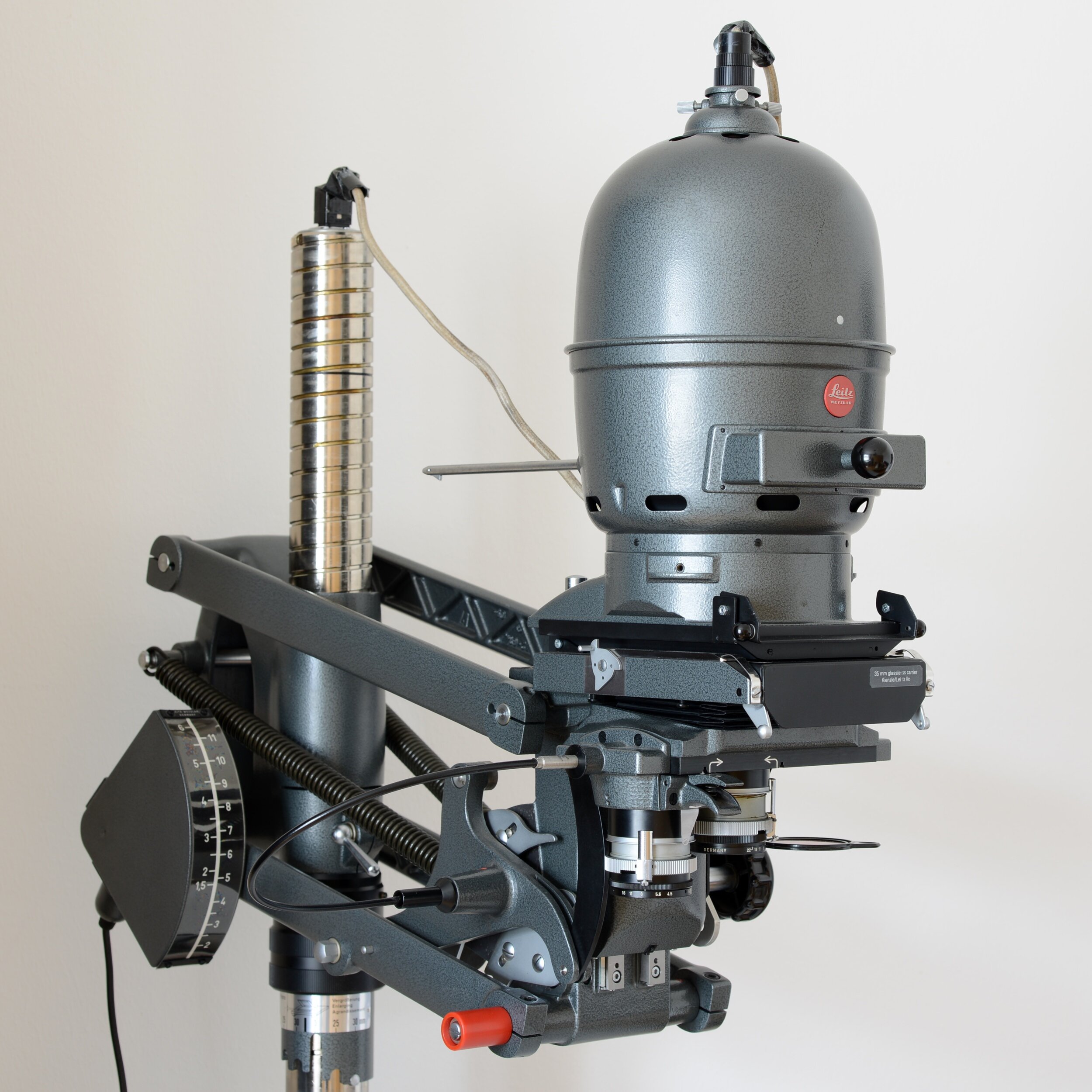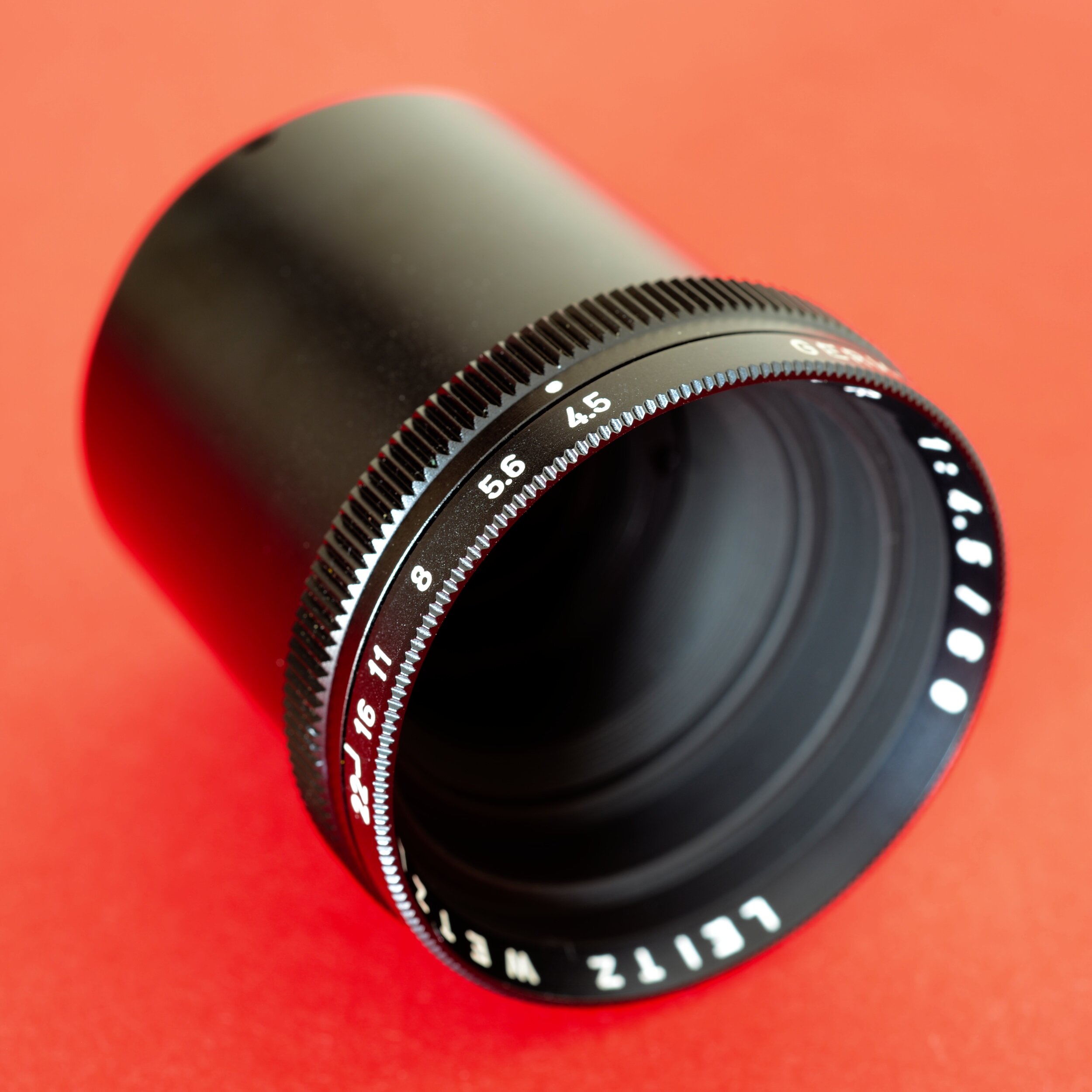Leitz Focomat IIc
Introduction
There are a few photographic tools with almost legendary reputation. The Leitz Focomat IIc enlarger is one of them. Introduced in 1956 it remained in production until 1983. When designing this 6x9 down to 35mm enlarger, Leitz Germany spared no expense – to own one of these formidable darkroom machines, the customer had to spend as much money as he would on a small automobile.
When I decided to set up a darkroom in my studio in Vienna, I decided to go for the best of the best – and bought a Focomat IIc which I completely refurbished. Six years later, it is time to dedicate a few lines to my companion.
Focomat IIc Grey Version, original baseboard and accessories
Review
Throughout the production era, Leitz changed the exterior color / coating of the Focomat IIc, the lenses and minor functional details. Apart from these, every Focomat IIc is identical. This review covers the light grey version, but I’ll mention some design differences the potential buyer has to be aware of.
General Remarks
The Leitz Focomat IIc is a medium (6x9) to small format (down to half-frame) auto-focus enlarger. It was built for professional use and Leitz designed it so that it would outlive multiple professional photographer’s / printer’s careers. The materials used are exquisite and highly durable or easily replaceable standard components (e.g. electric wiring).
Design
Unlike most contemporary enlargers, the Focomat IIc is a parallelogram enlarger. This means that the magnification is adjusted by moving the enlarger’s head which is mounted on a parallelogram contrary to moving a head mounted directly on a column.
The general downside of parallelogram enlargers is that they have to be exceptionally well made with no production tolerances, as they can’t be aligned after assembly. If an enlarger like this goes out of alignment (which a Focomat IIc never does unless it excessive force is applied by dropping it), the whole faulty parallelogram has to be replaced.
Apart from that I consider parallelogram enlargers superior in terms of design – mainly due to the convenient way in which the magnification is adjusted.
Focomat IIc - head and parallelogram detail view
Adjusting The Height / Magnification
The height can be adjusted very easily by unscrewing the clamp screw at the right hand side of the head. You don’t have to reach back to the column and start turning a height adjustment wheel. This makes the height adjustment much faster. For small changes of magnification, it is advisable to only partially unscrew the locking mechanism so it offers some resistance and therefore allowing for very precise adjustments.
When operated, the image stays centered on the baseboard.
The parallelogram only operates in a certain magnification range. If greater magnification is needed, the Focomat IIc has a threaded cuff to move the whole parallelogram further upwards.
Focomat IIc- illuminated enlarging scale and column detail
Illumination System
The Focomat IIc is equipped with a double condenser that sits below a standard E27 light bulb mount. The Focomat IIc is best operated with a 150W opal lamp, but can also take lower wattage types if desired.
Even illumination is key for quality enlargements and the Focomat IIc excels in that field. There is virtually no fall-off.
Thanks to the double condenser, the prints will benefit from micro-contrast and sharpness typical for condenser enlargers.
Focomat IIc - lamp head inside view
Focomat IIc - lamp head electrical cord & centering screws
Negative Carrier System
Out of the factory, Leitz delivered the Focomat IIc with a double Anti-Newton negative carrier with interchangeable mask inserts that mount below the bottom anti-newton glass.
This design ensures perfect negative flatness and rids the darkroom practitioner from fumbling with adjustable mask bands when changing film formats.
The masks are stored below the baseboard in an all-metal drawer.
Some versions of the Focomat IIc came with a pull-out light table below the baseboard on the left-hand side. This was meant to aid negatives insertion into the film carrier.
KIENZLE Germany offers replacement negative carriers and I purchased a glass-less negative carrier for 35mm – it is just easier to keep the small negative free of dust this way.
Original Leitz IIc negative carrier with AN-glass
KIENZLE glass-less film carrier for Focomat IIc
Focomat IIc - mask storage drawer
Optical System
The Focomat IIc comes with a double lens turret equipped with one lens for small format and another one for medium format. Thanks to this construction, the printer can alternate between medium format and small format without unscrewing lenses.
Focomat IIc - lens turret
Throughout the production era the lens system underwent minor improvements.
My Focomat IIc came with a Focotar 60mm f/4.5 for small format and a V-Elmar 100mm f/4.5 for medium format – both being quite late models.
Leitz Wetzlar Focotar 60mm f/4.5
Leitz Wetzlar V-Elmar 100mm f/4.5
Although the maximum apertures of these lenses don’t seem too exciting and might lead you to believe that these are low-quality lenses, I can attest that quite the contrary is true.
The smaller maximum apertures allow for a more favorable optical design and both lenses reach very good corner to corner sharpness when stopped down to f/5.6. From f/8 onward, I’d rate the performance as consistently excellent.
A comparison between the V-Elmar 100mm with the Rodenstock 80mm APO-Rodagon f/4 shows that the latter outperforms the first slightly in terms of sharpness. Whether or not this matters in practical use is up to the individual photographer to decide.
I’d like to note that KIENZLE Germany offers replacement lenses for the Focomat IIc.
Filter System
The Focomat IIc was conceived in a time when graded black and white paper was considered standard. Nonetheless, almost all IIc have a filter drawer above condenser. This means that filters for multigrade or color printing won’t have any detrimental effects on print quality.
KIENZLE offers a below-the-lens filter holders, spare filter drawers and multigrade filter systems for the IIc.
Focomat IIc - filter drawer
Auto-Focus System
One of the most notable features of the Focomat IIc is its auto-focus capability. When operated in a certain magnification range, a sophisticated mechanical focusing system keeps the image perfectly in focus.
AF-range for 35mm: 2-11x magnification range
AF-range for 120: 1.4-5.7x magnification range
I had no trust in auto-focus systems so I always checked twice before making an enlargement – only to find out that it worked every time.
The AF-system can be adjusted by the user if necessary, but I advise you try it as it is before messing with the focusing cams. Due to the exceptional precision build quality, there is usually no need to adjust it except focusing the lenses once.
Remember to follow the correct procedure when switching the lenses. The Bowden cable on the left hand side is for switching the focusing cams. When the lens revolver is not lifted properly and the system is operated with brute force, the cable might get damaged and has then to be replaced with a spare part by KIENZLE Germany.
Focomat IIc - lens switching lever
Focomat IIc - bellows and Bowden cable (left)
Some Thoughts
The Focomat IIc is an enlarger that has to be tried to fully comprehend its ingenuity. There are so many design features that make this device 40kg of darkroom perfection.
Everything is operated with a smoothness that no lesser enlarger has to offer. The Focomat IIc is German (over)engineering truly at its best and probably the most durable medium format to small format enlarger money can buy.
The only major downside is its price on the used market as well as that the lenses can’t be replaced with just any lenses. You have to either get adapted (and pricey, although excellent) Schneider lenses or get them serviced. Leica Germany still cleans the Focoatar / Elmar lenses, but they have no spare parts left.
Buying A Focomat IIc
In case I wet your appetite for the king of enlargers, I’d like to give you a few tips when looking for one.
Inspect the lenses for fungus. Oil and dust issues are serviceable by Leica, but when the glass is damaged by fungus, you have to buy costly replacements.
As the IIc is made out of massive metal components, it is extremely unlikely that it is out of alignment. Check for issues with the parallelogram nonetheless. If there is unusual friction and lubrication does not help – there is most likely something wrong.
Check for rust on all screws. As all screws were covered with protective lacquer or made out of stainless steel, so rust only appears when the enlarger was stored in very humid environments.
The newer Focomat IIc’s come with a laminated baseboard. If stored in humid conditions for an extended period of time, these boards might come apart and are in need of replacement – again: spare boards are available from KIENZLE.
The Focomat IIc was a professional tool and usually only bought by professional users. They are designed to stand the test of time – it is a good idea to to ask the seller about the enlarger’s history nonetheless and examine it for signs of (heavy) professional use.
The good news is that even if something is wrong with a Focomat IIc it can be fixed in 99% of all cases with spare parts from KIENZLE Germany. As these replacement parts are custom made, on demand by this renowned engineering company, this can be a costly (but worthwhile) endeavor.
Inform the seller if there is an issue with the enlarger and make sure to adapt the price accordingly. As a reference: A refurbished Focomat IIc (later version) is worth 2000 € at least.
Final Words
The Focomat IIc is the Leica among enlargers – costly but exquisite and living up to professional demands.
If you can’t find a Focomat IIc for a reasonable price, don’t worry:
KIENZLE offers a contemporary version of this legend: The A 69S.










